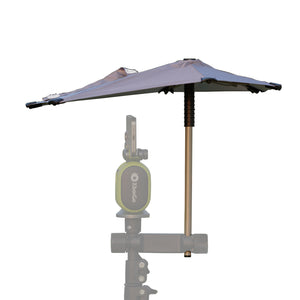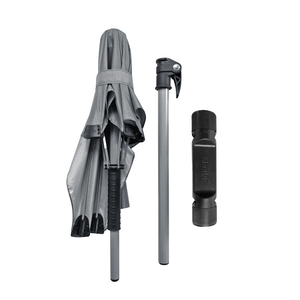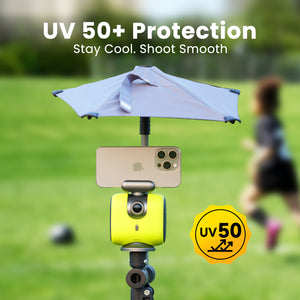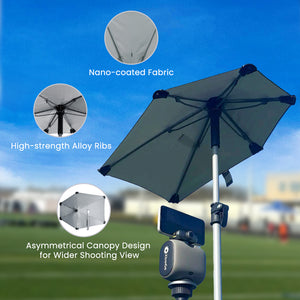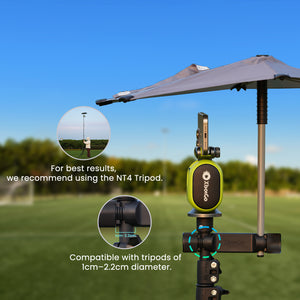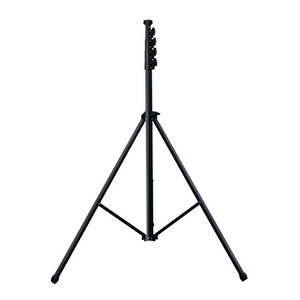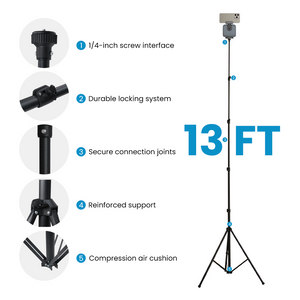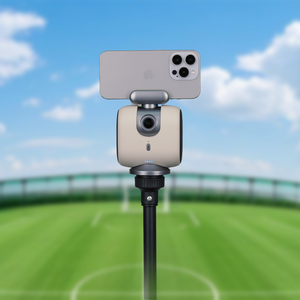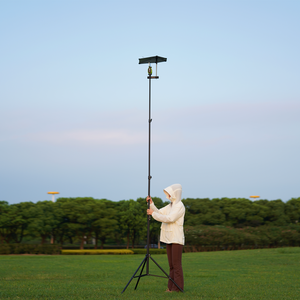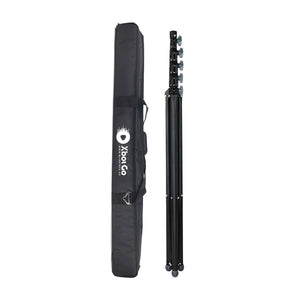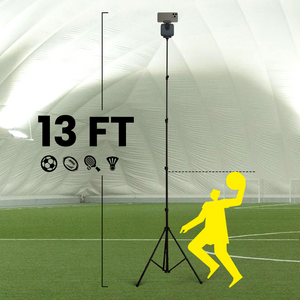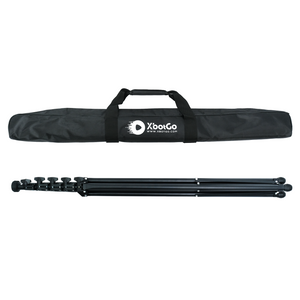XbotGo Chameleon AI Sports Camera
Hockeyschlägerlänge: Das Profi-Geheimnis, das die meisten Spieler nicht kennen
Hier ist etwas, das Sie vielleicht überraschen wird: Die Empfehlung zur Hockeyschlägerlänge, die Sie seit Jahren befolgen? Die ist wahrscheinlich falsch.
Die meisten Spieler messen ihre Schläger auf dieselbe Weise, wie es ihnen ihre Trainer vor Jahrzehnten beigebracht haben. Man stellt den Schläger aufrecht hin. Wenn er etwa zwischen Kinn und Nase reicht, ist alles in Ordnung, oder?
Nicht ganz.
Nach eingehender Analyse von Profispielerdaten, Trainererkenntnissen und Erfahrungsberichten von Spielern habe ich festgestellt, dass die traditionellen Richtlinien zur Schlägerlänge dich möglicherweise sogar behindern. Und wenn du ein älterer Spieler bist oder mit eingeschränkter Beweglichkeit zu kämpfen hast, könnte das Befolgen herkömmlicher Ratschläge dein Spiel sogar verschlechtern, anstatt es zu verbessern.
Lasst uns das ändern.
Das Problem mit traditionellen Empfehlungen zur Hockeyschlägerlänge
Die Messung des Abstands zwischen Kinn und Nase gilt im Eishockey seit Generationen als unumstößliche Wahrheit. Doch der Haken an der Sache ist: Sie basiert auf überholten Annahmen, die nicht der Realität des Spiels entsprechen.
Hockey-Legende Howie Meeker, Mitglied der Hall of Fame, wies bereits 1973 auf dieses Problem hin. Ihm fiel auf, dass Tausende von Kindern mit Schlägern anfingen, die „zwei bis vier Zoll zu lang“ waren. Seine Beobachtung? Wenn Spieler Schläger benutzten, die nur bis zum Kinn reichten, wurde ihre obere Hand hinter ihren Körper gezwungen. Versuchen Sie mal, so mit dem Schläger zu hantieren. Es ist nahezu unmöglich.
Die Beweislage wird überzeugender, wenn man sich die Vorteile ansieht.
Wayne Gretzky? Sein Schläger reichte ihm kaum bis zur Brust.
Sidney Crosby? Benutzt einen Schläger, der etwa 2 Zoll kürzer ist als das, was die meisten Trainer für seine Körpergröße empfehlen würden.
Der 1,93 m große Mario Lemieux benutzte einen Schläger, der nur 2,5 cm länger war als der seiner 1,83 m großen Teamkollegen.
Das sind keine Ausnahmen. Das ist die Regel unter Spitzenspielern.
Ein frustrierter Hockeyspieler brachte es perfekt auf den Punkt: „Ich bin 1,88 m groß und benutze einen 147 cm langen Schläger. Die Leute sagen mir ständig, dass er zu kurz für mich ist, aber alles, was länger ist, ruiniert meine Haltung.“
Kommt Ihnen das bekannt vor?
Was Profispieler tatsächlich verwenden (und warum es wichtig ist)
Schauen wir uns die Zahlen an, die wirklich zählen – was die besten Spieler der Geschichte tatsächlich benutzt haben.
Alex Hicks, Assistenztrainer an der Arizona State University und selbst ehemaliger NHL-Spieler, teilte einige aufschlussreiche Erkenntnisse über die Länge von Profi-Eishockeyschlägern. Seine Forschung zeigt über Jahrzehnte hinweg ein klares Muster:
1960er Jahre – Bobby Orr : Die Kelle liegt flach auf dem Eis, der Arm ist fast perfekt gestreckt an seiner Seite. Schlägerlänge? Deutlich kürzer als allgemein angenommen.
1980er Jahre – Wayne Gretzky : Der Schläger des „Großen“ war so kurz, dass sein Arm beim natürlichen Halten „fast perfekt gestreckt“ war. Das war kein Zufall.
1990er Jahre – Mario Lemieux : Trotz seiner Größe von 1,93 m war Lemieux' Schläger erstaunlich kurz. Beim Stockhandling hielt er seine untere Hand „direkt in der Hüfttasche“ – etwas, das nur mit einem Schläger der richtigen Länge möglich war.
2000er Jahre – Joe Sakic : Einer der besten Torschützen seiner Ära benutzte einen Schläger, der „vier Zoll unterhalb seines Kinns“ endete. Mit diesem „zu kurzen“ Schläger erzielte er 483 NHL-Tore.
2010er Jahre – Sidney Crosby : Crosbys Schläger reicht ihm auf Schlittschuhen etwa bis zum Schlüsselbein. Nicht bis zum Kinn. Nicht bis zur Nase. Schlüsselbein.
Das Muster ist eindeutig. Spitzenspieler aller Generationen wählten kürzere Schläger, als es die traditionellen Richtlinien empfehlen.
Warum? Weil kürzere Schläger Vorteile bieten, die in echten Spielen entscheidend sind:
- Bessere Puckkontrolle auf engstem Raum
- Schnellere Hände für schnelle Spielzüge
- Natürlichere Körperhaltung
- Überragende Stockhandling-Fähigkeiten
Die Wissenschaft hinter der richtigen Stocklänge
Worauf es bei der Wahl der richtigen Schlägergröße wirklich ankommt, ist der Kontakt der Kelle mit dem Eis.
Der ehemalige NHL-Spieler Paul Matthews bringt es am besten auf den Punkt: „Mit einem kürzeren Schläger konnte ich den Puck viel besser führen und Pässe leichter fangen.“
Das Grundprinzip ist einfach: In deiner natürlichen Hockeyposition sollte die gesamte Kufe flach auf dem Eis aufliegen. Deine Hände sollten sich vor deinem Körper befinden, nicht an deiner Hüfte anliegen.
Doch individuelle Unterschiede spielen eine größere Rolle, als die meisten Ratgeber anerkennen:
Unterschiedliche Armlängen : Zwei Spieler gleicher Größe können allein aufgrund ihrer Armlänge unterschiedliche Schlägerlängen benötigen. Deshalb funktioniert der Ansatz „Einheitsgröße“ nicht.
Schlittschuhhaltung : Wie tief du von Natur aus Schlittschuh fährst, beeinflusst die ideale Schlägerlänge. Hobbyspieler, die eher aufrecht laufen, benötigen andere Maße als Spieler mit stark gebeugten Knien.
Alter und Flexibilität : Ein wichtiger, aber selten thematisierter Punkt. Ein 46-jähriger Spieler erzählte: „Von 7 bis 22 Jahren hielt ich meinen Schläger am Kinn … Aber vor zwei Jahren habe ich wieder angefangen zu spielen … Ich habe ihn um fünf Zentimeter verlängert und fühle mich jetzt viel wohler. Er berührt jetzt meine Lippen. Vielleicht liegt es daran, dass ich älter und nicht mehr so flexibel bin?“
Mit zunehmendem Alter lässt unsere Beweglichkeit nach. Unsere Haltung beim Schlittschuhlaufen wird aufrechter. Die Schlägerlänge, die mit 20 noch gut funktionierte, kann mit 40 Rückenschmerzen verursachen.
Lie-Winkel des Schlägers : Die meisten im Handel erhältlichen Hockeyschläger haben einen Lie-Winkel zwischen 5 und 6. Der Unterschied? Nur etwa 2 Grad. Wenn die Schlägerlänge stark abweicht, hilft auch keine Lie-Anpassung mehr.
Positionsspezifische Schlägerlängenstrategien
Ihre Position beeinflusst die ideale Stocklänge – aber vielleicht nicht so stark, wie Sie denken.
Forwards: Argumente für kürzere Positionen
Stürmer profitieren am meisten von kürzeren Schlägern. Hier ist der Grund:
Das Dangler-Profil : Spieler, die sich auf Stockführung spezialisieren, benötigen maximale Kontrolle. Ein kürzerer Schläger (auf Kinnhöhe oder darunter) ermöglicht Ihnen Folgendes:
- Den Puck auch auf engstem Raum schnell bewegen
- Halte den Puck nah am Körper.
- Führe diese spektakulären Finten aus!
Das Spielmacherprofil : Center, die Bullys gewinnen und schnelle Pässe spielen, bevorzugen oft Schläger in Kinnhöhe. Das bietet die perfekte Balance zwischen Kontrolle und ausreichender Reichweite für Defensivaktionen.
Ein Beispiel aus der Praxis: Patrick Kane , einer der besten Stocktechniker der NHL, verwendet einen auffallend kurzen Schläger. Beobachten Sie, wie er sich durch die gegnerischen Reihen schlängelt – die Schlägerlänge behindert ihn nicht.
Verteidiger: Die richtige Balance finden
Die Verteidiger stehen vor einer besonderen Herausforderung. Sie brauchen Reichweite für Poke-Checks, dürfen aber nicht zu viel Kontrolle einbüßen.
Der moderne Verteidiger : Heutige Verteidiger benutzen oft Schläger, die nur geringfügig länger sind als die der Stürmer – vielleicht ein paar Zentimeter über Kinnhöhe. Warum? Weil sie Folgendes benötigen:
- Schnelle Outlet-Passagen
- Schließen Sie sich dem Ansturm an!
- Den Puck unter Druck handhaben
Der defensive Mittelfeldspieler : Traditionelle Verteidiger verlängern ihren Schläger oft um einen Zentimeter, um maximale Reichweite zu erzielen. Aber selbst Zdeno Chara, mit seinen 2,06 m, brauchte eine Sondergenehmigung für seinen extralangen Schläger. Sie wahrscheinlich nicht.
Mark Stone von den Vegas Golden Knights ist ein interessantes Beispiel. Er verwendet einen 65 Zoll langen Schaft (länger als der Durchschnitt) und gehört regelmäßig zu den Top 10 der NHL bei Puckgewinnen. Bekannt ist er aber auch für seinen ungewöhnlich großen Schlägerknauf – eine weitere persönliche Vorliebe, die gut zu seinem Spielstil passt.
Die Herangehensweise des Grinders
Spieler, die in den Ecken und vor dem Tor kämpfen, bevorzugen oft eine mittlere Position. Ein Schläger durchschnittlicher Länge hilft ihnen dabei:
- Pucks aus den Ecken holen
- Position vorne beibehalten
- Schnelle Spielzüge im Verkehr
Die Lehre daraus? Dein Spielstil ist wichtiger als deine Position.
So messen Sie die perfekte Stocklänge
Vergessen Sie für einen Moment die Kinn-Nase-Regel. Lassen Sie uns herausfinden, was für Sie wirklich funktioniert.
Methode 1: Der Klingenkontakttest
Das stammt von Leuten, die es durch Ausprobieren herausgefunden haben:
- Zieh deine Schlittschuhe an (oder stell dich auf etwas, das 5-7,5 cm hoch ist).
- Nehmen Sie Ihre normale Spielhaltung ein.
- Halten Sie den Stock nur mit Ihrer oberen Hand fest.
- Senke den Stock ab, bis die Klinge flach auf dem Boden aufliegt.
- Achten Sie darauf, wo Ihre Hand den Schaft greift – das ist Ihre ideale Länge.
Wenn Sie hinter Ihren Körper greifen oder sich nach vorne beugen müssen, um die Klinge flach zu bekommen, ist der Stock zu lang.
Methode 2: Überprüfung der Armposition
Pro Stock Hockey empfiehlt folgende Vorgehensweise:
- Halten Sie den Stock normal mit beiden Händen
- Lassen Sie Ihre Arme locker an Ihren Seiten hängen.
- Die Kufe sollte flach auf dem Eis aufliegen.
- Ihr oberer Arm sollte relativ gerade sein, nicht unnatürlich angewinkelt.
Zeigt die Spitze nach oben, ist der Stock zu lang. Hebt sich die Ferse, ist er zu kurz.
Methode 3: Der Test der Spielposition
Diese Methode ist simpel, aber effektiv:
- Nimm deine normale Hockey-Haltung ein.
- Einen imaginären Puck mit dem Schläger führen
- Können Sie den Puck bequem um Ihren Körper herum bewegen?
- Bleiben Ihre Hände vor Ihren Hüften?
Falls Sie eine der beiden Fragen mit Nein beantwortet haben, passen Sie die Länge an.
Der konservative Schnittansatz
Marcel von Marcels Hockeyschule gibt folgenden Profi-Tipp: „Wenn Sie einen neuen Schläger kaufen, kürzen Sie ihn vielleicht nicht ganz so stark wie sonst. Schneiden Sie ihn ein Stück länger ab und probieren Sie es bei einem Training aus.“
Ein kluger Rat. Man kann immer noch mehr abschneiden. Man kann es nicht wieder hinzufügen (Erweiterungen gibt es zwar, aber sie sind nicht ideal).
Häufige Probleme mit der Stablänge beheben
Lasst uns die häufigsten Probleme mit der Schlägerlänge lösen, mit denen Spieler konfrontiert sind.
Anzeichen dafür, dass Ihr Stock zu lang ist
- Der Hüftpflock : Beim Stockhandling verhakt sich deine obere Hand an deiner Hüfte.
- Fersenlastig : In der normalen Haltung berührt nur die Ferse Ihrer Kufe das Eis.
- Der Puck rutscht unter : Der Puck rutscht immer wieder unter die Spitze Ihrer Kelle.
- Ungeschicktes Passspiel : Sie haben Schwierigkeiten, Pässe sauber anzunehmen.
- Erzwungene Reichweite : Sie müssen sich unangenehm strecken, um den Puck in der Nähe Ihrer Füße zu kontrollieren.
Ein Spieler brachte es perfekt auf den Punkt: „Es ist, als würde man zu einem Stabhochsprungwettbewerb antreten.“
https://www.youtube.com/watch?v=CScWrTbAFz4
Anzeichen dafür, dass Ihr Stock zu kurz ist
- Der Glöckner von Not : Du bist in deiner normalen Haltung zu weit nach vorne gebeugt.
- Zehentänzer : Nur die Spitze deiner Kufe berührt das Eis.
- Begrenzte Reichweite : Du kannst nicht effektiv poke-checken.
- Schwache Schüsse : Deine Schlagschüsse haben zu wenig Kraft (der Hebel ist zu klein).
- Rückenschmerzen : Besonders häufig bei älteren Spielern – ein wichtiges Warnsignal
Schnelle Lösungen, während Sie sich entscheiden
Zu lange :
- Den Stick vorübergehend weiter oben greifen
- Passen Sie die Position Ihrer unteren Hand an.
- Arbeite an deiner Kniebeuge
Für Too Short :
- Fügen Sie eine Verlängerungssteckdose hinzu (vorübergehende Lösung).
- Korrigiere deine Skating-Haltung leicht.
- Achten Sie darauf, die Klinge trotz ihrer Länge flach zu halten.
Wann sollte man Änderungen vornehmen?
Wann ist der beste Zeitpunkt, um mit der Schlägerlänge zu experimentieren? Im Training oder bei Freundschaftsspielen. Vor wichtigen Spielen sollten Sie niemals drastische Änderungen vornehmen.
Wenn Sie jahrelang die gleiche Länge verwendet haben und es sich plötzlich falsch anfühlt, sollten Sie Folgendes bedenken:
- Haben Sie deutlich an Gewicht zu- oder abgenommen?
- Hat sich Ihre Flexibilität verändert?
- Spielst du eine andere Position?
- Hast du die Marke oder das Modell deines Sticks gewechselt?
Jeder dieser Faktoren kann die ideale Stocklänge beeinflussen.
Wichtigste Erkenntnisse
Nach der Analyse von Profispielern, Erkenntnissen der Trainer und realen Spielererfahrungen ist Folgendes entscheidend:
- Traditionelle Ratschläge sind nur ein Ausgangspunkt . Die Kinn-Nase-Regel funktioniert für manche, aber nicht für alle.
- Profispieler verwenden durchweg kürzere Schläger , als man gemeinhin annimmt. Dafür gibt es einen Grund.
- Die ideale Länge hängt von mehreren Faktoren ab : Körpergröße, Armlänge, Flexibilität, Alter, Position und Spielstil spielen alle eine Rolle.
- Der Kontakt der Kufe mit dem Eis ist entscheidend . Wenn die Kufe in deiner normalen Haltung nicht flach auf dem Eis aufliegt, stimmt die Länge nicht.
- Komfortempfinden verändert sich mit dem Alter . Was mit 20 noch funktionierte, muss mit 40 nicht mehr passen. Passen Sie Ihre Gewohnheiten entsprechend an.
- Kleine Veränderungen können große Unterschiede machen . Schon ein Zentimeter kann deine Puckkontrolle und Schusstechnik grundlegend verändern.
Der Spieler, der Howie Meekers Weisheit weitergab, brachte es am besten auf den Punkt: „Ich fand, dass der kürzere Schläger mir enorm bei der Puckkontrolle und der Kraft in Zweikämpfen auf engem Raum half.“
Zeit zum Experimentieren
Hier ist eure Hausaufgabe: Hinterfragt alles, was euch über die Stocklänge erzählt wurde.
Versuche, deinen Stock einen Zoll kürzer als gewöhnlich abzuschneiden. Nur zum Üben. Mal sehen, was passiert.
Testen Sie während der Puck- und Stockübungen verschiedene Längen. Achten Sie dabei auf Folgendes:
- Wie natürlich sich Ihre Stockführung anfühlt
- Ob Ihre Kufe flach auf dem Eis bleibt
- Wenn Ihre Hände vor Ihrem Körper bleiben
- Wie sich Ihr Rücken nach dem Spielen anfühlt
Denk daran: Es geht nicht darum, was laut irgendeiner Tabelle „richtig“ ist. Es geht darum, herauszufinden, was dein Spiel verbessert.
Die beste Schlägerlänge ist die, mit der du dein bestes Hockey spielen kannst. Punkt.
Und wenn dir jemand sagt, dein Schläger sei zu kurz? Zeig ihm einfach Sidney Crosbys Maße. Damit ist das Gespräch meist schnell beendet.
XbotGo Chameleon AI Sports Camera
Capture every moment with AI-powered tracking. Perfect for coaches, parents, and athletes who want seamless footage without manual filming.







 Soccer
Soccer Basketball
Basketball Ice Hockey
Ice Hockey Rugby
Rugby










